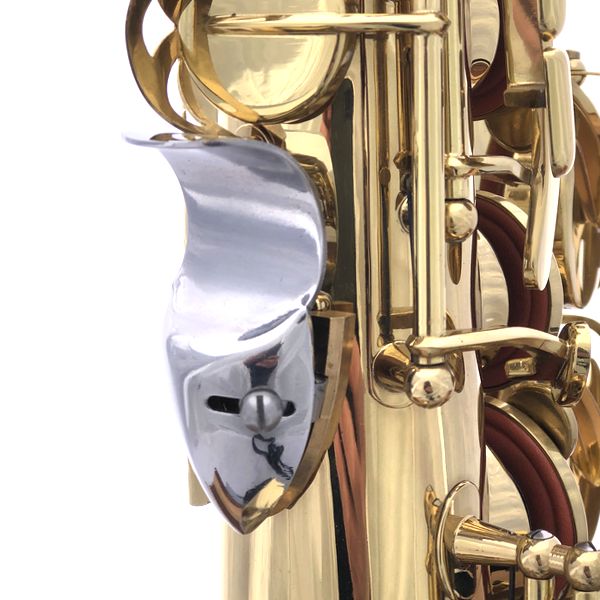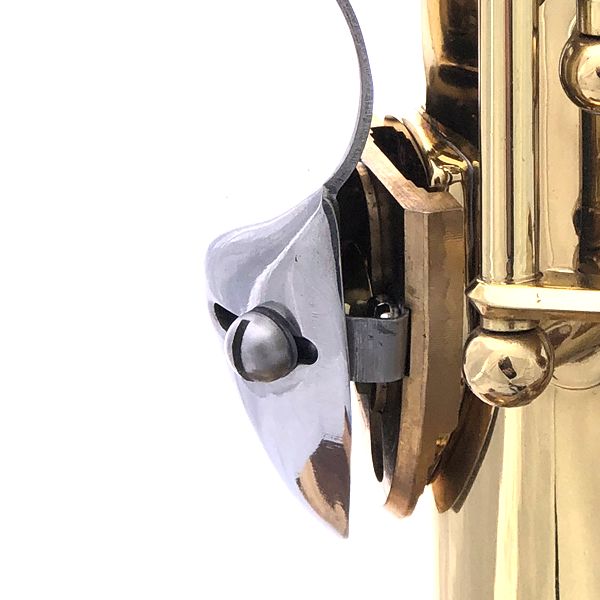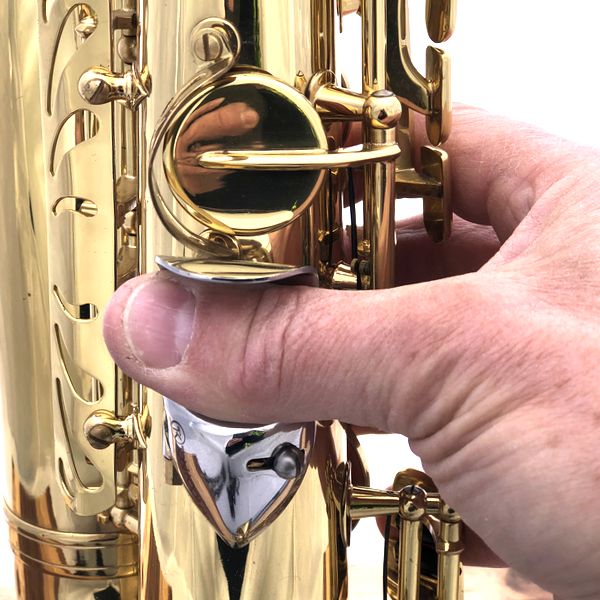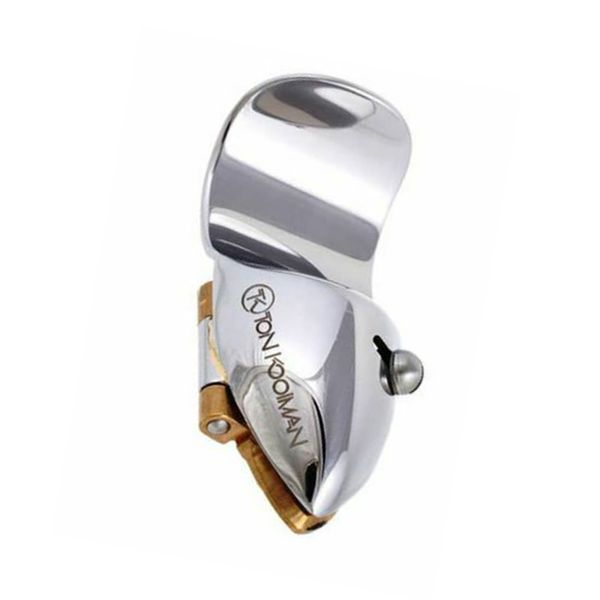The Forza thumb rest for Saxophone
A better, relaxed position of the right hand thumb enhances both the relaxation and the freedom of movement of the other fingers, making technical phrases easier (faster) to play. The little finger moves more easily to the two lowest keys also.
With the hinge at the left and adjustment right, the Forza can be adjusted upwards at the right side to support the thumb ergonomically. The thumb is held higher and is either straight or slightly bent and does not “sag”.
Adjustable
The Forza Thumb rest for Saxophone can be adjusted in height. Most of the time closest to the protection rail of the F/sharp. And the right side of the thumb rest, the “spoon” can be adjusted upwards. Allowing a more relaxed hand position.
Ergonomics
When you let your hand hang down alongside your body/leg, letting it be totally relaxed and placed on the instrument again, you often find the old hook getting in the way. And the thumb at a different angle also. Not pulled inwards and the tip of the thumb upwards, but the other way round. This relaxed hand/thumb position can be obtained with the Forza Thumb rest. The thumb resting in the lower part of the “spoon”. Straight or slightly bent as
your thumb usually is when doing nothing. Then you can play much easier.
Effortless
In this way the situation moves towards YOU, your individual unique demands, instead of complying to a given one. Instead of “hanging in the tendons”, the musician will now carry the instrument in an “active” way!
Reviews
Jason Schwager
My first saxophone was a soprano. I also play tenor and have installed Forza’s on all my ten of my horns. The great benefit to me of the Forza is that the designer, Ton Kooiman, is the only engineer who correctly identified the ergonomic problem and solved it. Namely, before the Forza, I was using the common thumb hook which tends to force the thumb to be bent abnormally backward into what I call the ‘hitchhiker’ position. This is okay for very short periods, but any serious player who wants to spend time with his horn may find as I did that when the thumb is in the hitchhiker position and repeatedly stressed isometric ally with the tensioning and release and then re-tensioning of the tendon repeatedly as your hand works the other fingers, one will likely develop tendonitis. Similar to carpal tunnel of the wrist, the tendonitis in the thumb was very painful. A neckstrap used in conjunction with a Forza totally solved the problem for me. Everyone is different and some people don’t encounter the problem. Those that do, and that includes me, will find the Forza a godsend.
Thomas
Dear Ton, I’m a big fan of your thumbrests (1 Maestro and 2 Etudes for my clarinets, 2 Forza for my saxes). Before I discovered them I had many problems with my hand and arm, caused by tension and unergonimical original thumb rests. Kind regards and greetings from Germany,
Mike Hall
I first approached Ton Kooiman to ask if his clever clarinet thumb rests would work with the soprano saxophone. Like most soprano players I know, I have acute problems with pain in my right thumb and wrist; transferring the weight down to the joint of thumb and first finger might have been a good solution. Ton explained why this wasn’t practical but that I should try his Forza Thumb rest.
I managed to fit the Forza to my Selmer MK VI tenor easily. The first thing I noticed was that it allows the thumb to lie in a natural position; at the same level as the first finger, as it would if you were holding a paper cup full of hot coffee! The thumb rest of most saxophones forces the thumb downwards. Indeed, my perceptions of most saxophone design is ‘the tone holes must go here, here and here so we will just have to stick the thumb rest wherever there is space left for it!’ I bought a second Forza for my Yanagisawa curved soprano and found that I could position my thumb over the top of the F# trill key tone hole; just where it should be. Because of the positioning and shape of the Forza, the thumb is concentrating on pushing forward rather than upwards which is exactly what it should do! The ‘lift’ is provided by the sling! There is no need for the ‘hook’ as on conventional plastic thumb rests. The Forza offers an increased element of flexibility to my overall playing posture. It is not cheap but it is beautifully made and set against the cost of a professional saxophone worth every penny. Indeed, it should be standard on all new saxophones! I have been using the Forza for over two years now and haven’t given it a second thought! Just what is required from such an important ‘man-machine’ interface! However, I’d still like to find a soprano saxophone which weights the same as a clarinet!
Mike Hall is Professional saxophonist based in Manchester, UK. He is Head of Jazz Studies and Tutor in Jazz Saxophone at the Royal Northern College of Music. mikehall.co.uk
FAQ
empty first row
What are the ergonomic benefits of the Forza Thumb Rest?
The Pressure point on the thumb is moved from the first phalanx to the space between the two joints of the thumb. The Lever momentum is much smaller at this new point, which makes carrying the weight far more easier than before and enables an easier reach of lower keys.
How to mount Forza Thumb Rest?
The well known removable hook can be taken off and with the original screw, the Forza Thumb Rest can be screwed onto the body (on the base plate) of this horn with this original screw also. Distance from the centre of the mounting screw and the F-sharp rail, requires 36 mm to be able to mount the Forza Thumb Rest.
How to adjust the Forza Thumb Rest?
Forza and why not a Maestro2 on a saxophone?
At the time when we designed a thumb rest for saxophones, this was of course the first thing that would enter the mind. But the padded adjustable part of the maestro is not needed because you carry the instrument with a neck strap. (Carrying otherwise would be destructive for your thumb) and it would restrict movement towards the side keys as well. Furthermore the casing of the maestro makes the body to wide and fixing it to the instrument quite impossible. The Forza solves all these issues. And note well, to hold the thumb slightly bent downwards instead of upwards under a hook with a relaxed hand, joint neutral.
On which saxophones brands can the Forza Thumb Rest be applied?
- Selmer (Paris and USA)
- Buffet Crampon. (not the old S1-Prestige)
- Jupiter
- Yamaha
- Guardala
- B&S
- Yanagisawa (sometimes the rail of the side-F-sharp is hit. It takes a repairman to mount in this case)
- Toneking
- Keilwerth
- Many student and prof. instruments from Korean and Taiwan makers.
- Cannonball
The Forza can be used on the Baritone as well, but only advisable when the musician has large hands (to prevent overstretching).
Forza why Stainless steel not Gold plated?
These stainless Forza Thumb Rests are extremely durable, but I’ll admit Gold looks much better. I will try to find Stainless steel with a gold color like the a specific mouthpiece I have once seen.




